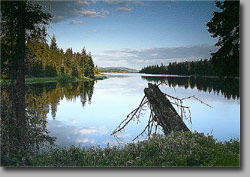










This method is based on the fact that JPEG algorithm behaves differently in contrast areas in comparison to places which are more or less flat or have softer gradients. Whole theory is deeply wedded within the principles of the division of quantization matrix - it is little bit higher math, so if you want to know more about it, just type "JPEG Algorithm" into GOOGLE.
Essentially all you need at this moment is a graphic editor that supports JPEG format and has image sharpening ability. Most of you propably know Adobe Photoshop which, of course, will make it much easier for me to explain these steps.
First of all it is important to decide what is the final resolution of picture you want to have as a result. For example images posted at GFXartist have to be no wider than 716 pixels. If you have picture in original resolution 3072 x 2048 pixels and you want to resample it into 716x477, you shall do it in two or three steps. Before each step the picture needs to be sharpened (or oversharpened, to be precise). It is also important to keep on mind that ideal quality of final picture is kept in case you're shrinking image to perfect 50%, otherwise "pixelation" may appear.
Step-by-step:
- Open picture in original resolution
- Duplicate layer
- Apply SHARPEN or SHARPEN MORE on the new layer
- Change image size to 1432 pixels width (716 x 2 = 1432)
- Duplicate the new layer
- Apply SHARPEN or SHARPEN MORE on that new layer
- Change image size to 716 pixels width
- optionally you can duplicate last layer and apply unsharp mask if you want. Amount: 90% Radius: 0,3 pixels Threshold: 0 levels
- now you can regulate intensity of effect by changing opacity of layers
- if pixelation will appear on some local places you can carefully remove it by ERASE TOOL
- flatten image
 Original size 2736 x 1905 |
 SHARPEN MORE |
 200% of destination size 1432 x 977 |
 SHARPEN MORE |
 Destination size 716 x 499 |


